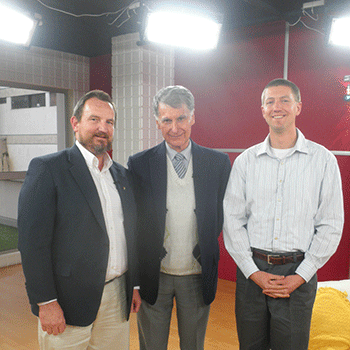Flying into El Alto International Airport in Bolivia in winter is breathtaking, both literally and figuratively. When Michael Mullins, MD, landed at the high altitude of 14,000 feet, he was awed by the craggy, snow-capped Andes mountains poking through the clouds.
For a week in January, Mullins, associate professor of emergency medicine at Washington University School of Medicine in St. Louis, shared his expertise in emergency care with doctors, nurses and paramedics in this mostly rural, poor country in South America. He and other U.S. health-care workers came to Bolivia through Project Helping Hands, an organization that provides medical care and health education to people in developing countries.
“As I get older, I’m more interested in doing mission work,” said Mullins, whose first Spanish teacher at a high school in Del City, Okla., happened to be from Bolivia. “I have admired people who take time out of their lives to help others in foreign countries, which motivated me to volunteer.”
During the week, Mullins and another physician, four nurses and a paramedic taught classes mostly in Spanish on toxicology, disaster preparedness, how to evaluate pediatric patients and other topics. They also conducted a mass-casualty triage and assessment exercise.
Mullins was struck by the popularity of the classes, with attendees sitting shoulder to shoulder in the rooms where they were held. In Cochabamba, called the Garden City, the team lectured at a private hospital; in La Paz, an ancient Spanish city, they taught classes at the medical society.
Emergency medicine is recognized as a specialty in Bolivia, but there are few people trained in this area. People who work in emergency medicine have specialized in family medicine, surgery or internal medicine.
“It’s similar to our system 30-40 years ago in the United States,” said Mullins, who specializes in toxicology and treats patients in the emergency department at Barnes-Jewish Hospital. “In Bolivia, there are no emergency medicine residency programs.”

In this country of 10 million people, children up to age 5 and adults older than 65 receive government health insurance. The general public pays for health care at public and private hospitals.
Private hospitals, which are more expensive but have shorter wait times, have emergency rooms similar to those in U.S. community hospitals, Mullin says. Public hospitals also house emergency rooms.
One of the most common medical emergencies in Bolivia is attempted suicide, and the method of choice is poisoning. Physicians working in emergency rooms see patients who have ingested rat poisoning or paraquat, a weed herbicide that’s banned in the United States. They also treat patients who have sniffed glue or taken too much acetaminophen.
There is no poison database or poison center for Bolivians to call. “People who’ve ingested something go to the hospital and hope a physician is familiar with the substance they took,” he said.
While the team spent most of their time in the classroom, they also took a day trip to Chacaltaya, the site of an old glacier that once was Bolivia’s only ski resort. Additionally, they sampled some of the local culture by eating corn and potato dishes and stews of llama, chicken and beef tongue.
Mullins is one of a handful of WUSTL emergency medicine physicians who have traveled to Bolivia in recent years, through Project Helping Hands and other organizations, to teach health-care professionals.
Mullins said he’s glad he was able to share some of his expertise in emergency medicine and toxicology. “I hope to return to Bolivia one day,” he said. “The people we taught are eager to become better health-care professionals, and they look to the United States as a source of information, teaching and knowledge.”
Washington University School of Medicine’s 2,100 employed and volunteer faculty physicians also are the medical staff of Barnes-Jewish and St. Louis Children’s hospitals. The School of Medicine is one of the leading medical research, teaching and patient care institutions in the nation, currently ranked sixth in the nation by U.S. News & World Report. Through its affiliations with Barnes-Jewish and St. Louis Children’s hospitals, the School of Medicine is linked to BJC HealthCare.